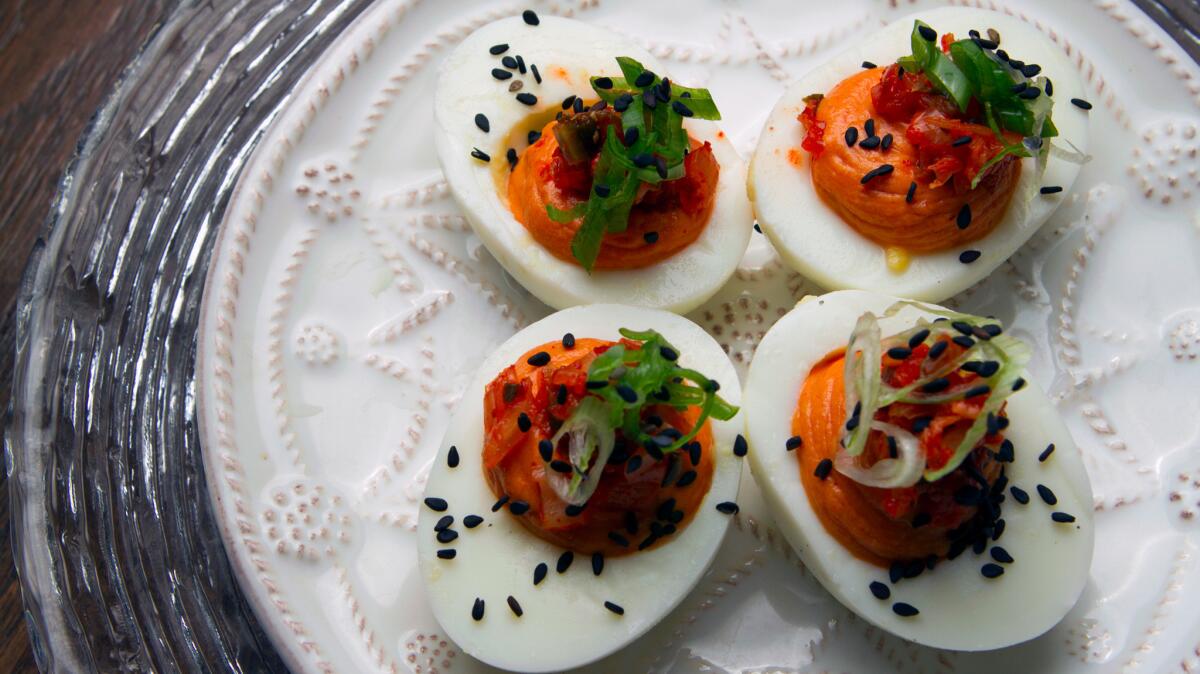How to make those oh-so-addictive kimchi deviled eggs from Faith & Flower

- Share via
For nearly a decade, Korean flavors have dominated restaurant menus in Los Angeles. Just thank Roy Choi and his Kogi Korean BBQ food truck. You can easily find chicken wings covered in gochujang (fermented chile paste), bulgogi in your tacos and kimchi on anything from burgers to pizza to mac ‘n’ cheese. The spicy fermented cabbage has gone from an essential Korean BBQ banchan, or appetizer, to a condiment you can find on most grocery store shelves — and on menus everywhere.
And there may be no more addictive kimchi dish in town right now than the deviled Jidori eggs at Faith & Flower downtown. There’s nothing quite like taking a classic American dish (deviled eggs may have actually originated in Italy, but they have been popular in America since post- World War II) and giving it a lashing of kimchi juice and gochujang. The familiar, pale yellow deviled egg filing is a vibrant orange, with just enough heat. Faith & Flower actually makes its own kimchi for the eggs, which are topped with more kimchi before serving. Because in life, you can never have enough spicy fermented cabbage — or deviled eggs.
FAITH & FLOWER’S DEVILED JIDORI EGGS
1 hour, 45 minutes, plus chilling and marinating time. Makes 24 deviled eggs
KIMCHI
1 head napa cabbage
2 tablespoons salt
1/4 cup gochujang paste
1/4 cup Korean chile flakes (gochugaru)
3 1/2 tablespoons water
1/4 cup rice vinegar
4 large garlic cloves, finely chopped
1 tablespoon finely grated ginger
1/3 cup very thinly sliced onion
1/3 cup julienned daikon radish
3 green onions, cut into 3-inch sections
1. Remove the outer leaves of the napa cabbage and cut the cabbage into quarters lengthwise. Rinse the cabbage thoroughly between the leaves and dry the cabbage well.
2. Salt the cabbage, being sure to spread the salt evenly between the leaves. Place the salted cabbage in a plastic or non-reactive colander or strainer and place the colander over a bowl to collect any liquid. Set the cabbage aside for 30 minutes.
3. Meanwhile, combine the gochujang paste, chile flakes, water, vinegar, chopped garlic and grated ginger in a food processor, and pulse the ingredients to form a coarse paste.
4. Rinse the salted cabbage under cold running water, making sure to rinse the salt out from between each leaf. Dry the cabbage completely on clean towels. Cut each quarter crosswise into 2-inch to 3-inch strips, discarding the core. Place the cabbage in a glass or other non-reactive bowl and toss with the onion, radish and green onion.
5. Add the paste to the bowl, massaging it into the cabbage leaves and vegetables. Place the mixture into a deep non-reactive container (such as an 8-cup measuring cup), and weight the mixture down. Refrigerate 1 to 2 days before using to give the flavors time to ripen. This makes a scant quart of kimchi, which will keep for up to a week, refrigerated.
AIOLI
2 egg yolks
4 teaspoons rice vinegar
1 1/2 tablespoons water
1 1/2 cups grapeseed oil
1/4 teaspoon salt, divided, or to taste
6 to 7 cloves garlic, finely minced
In a large bowl, whisk together the egg yolk, vinegar, water and 1/8 teaspoon salt until the yolks are velvety and a pale yellow. Very slowly, drizzle in the oil, whisking all the time, to emulsify and form a mayonnaise. Once all of the oil is added, stir in the garlic. Taste, and season with an additional 1/8 teaspoon salt, or as desired. This makes a generous 1 1/2 cups aioli.
DEVILED EGGS
1 dozen eggs
2 tablespoons salt, plus more to taste
3 tablespoons to 1/4 cup white wine vinegar, to taste
1 1/4 to 1 1/2 cups aioli
2 tablespoons gochujang paste
1/2 teaspoon toasted sesame seed oil
2 tablespoons juice from kimchi
Pepper
Chopped kimchi, for garnish
Toasted black sesame seeds, for garnish
Slivered green onion or chive strands, for garnish
1. Boil the eggs: Bring a large pot of water, along with the 2 tablespoons salt and the vinegar, to a boil over high heat. Carefully add the eggs. Cook the eggs for exactly 14 minutes, then drain and place the eggs in ice to cool immediately.
2. Once the eggs have cooled, carefully peel them. Using a length of thread or unflavored floss, halve the eggs lengthwise. Remove the cooked yolks (the yolks should be just cooked, with a bit of translucence at the center), and set aside. Clean the egg whites and refrigerate, covered, in a single layer.
3. In a food processor, combine the egg yolks, 1 1/4 cups aioli, gochujang paste, sesame oil and kimchi juice. Pulse until the ingredients are thoroughly incorporated and the mixture is smooth. Adjust the consistency as desired with additional aioli. Taste and adjust seasoning as desired with additional salt and pepper. This makes about 2 to 2 1/2 cups filling. Place the mixture in a piping bag.
4. Pipe the mixture into each of the egg white halves. Garnish the deviled eggs with a little chopped kimchi, a sprinkling of sesame seeds and slivered green onion. Serve immediately.
Note: Adapted from a recipe by chef Michael Hung, formerly of Faith & Flower. Although many recipes, such as the aioli, call for raw egg yolks, the U.S. Department of Agriculture recommends that diners -- especially children, seniors, pregnant women and those with compromised immune systems -- avoid eating them.
More to Read
Eat your way across L.A.
Get our weekly Tasting Notes newsletter for reviews, news and more.
You may occasionally receive promotional content from the Los Angeles Times.











